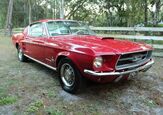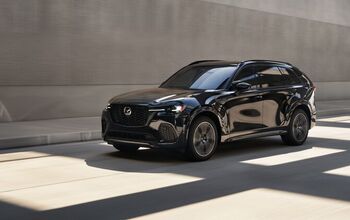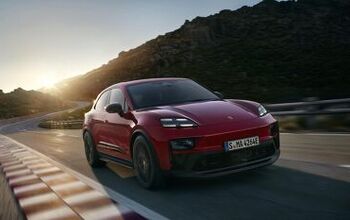2025 Toyota Camry SE AWD Review: Prius Plus

We don’t give “predictable” enough credit.
Look at the billions of minutes The Office racks up in streaming every year, despite wrapping up in 2013. Our collective predisposition towards “reconsumption,” to use the term from a 2011 study, isn’t a negative: it’s a move that allows our brains to relax, safe in the comfort of the familiar in an increasingly busy world.
The 2025 Toyota Camry SE is certainly familiar. Sure, there are big changes hiding within the unchanged dimensions: an all-hybrid lineup, big cabin upgrades, those Prius-like looks. Yet the core experience is as Camry as ever, and during a week that saw a lot of uncertainty and change, I was grateful for that.
2025 Toyota Camry SE AWD Quick Take
There’s not a lot of surprise with the newly all-hybrid 2025 Toyota Camry—and that’s the point. A reasonable price and a welcome improvement to refinement make this an excellent if unexciting choice for sedan shoppers.
What’s New for 2025:
We’ve already covered that, haven’t we? Toyota has dropped the gas-only engine choices, leaving just the hybrid, available in either front- or all-wheel drive. The cabin sees a major restyle, and a long-overdue switch to Toyota’s latest infotainment. Wrapping it all up is a redesign that heavily borrows from the Prius.
Exterior Style:
How you feel about the new Camry looks largely depends on how you feel about the Prius. It’s also clearly not a clean-sheet look: more of a Prius sandwich, with the two ends adopting the look while the parts between A- and C-pillars are identical to the outgoing car. Go on: put your finger(s) over the the new “hammerhead” panel between the headlights, leaving only their outer halves. See? It’s the same car.
That’s fine: the 2018 redesign gave the Camry style, and this ‘25 only seeks to keep it looking current. Against the sober, sleepy Honda Accord and the futuristic yet fussy Hyundai Sonata—and the ancient Nissan Altima—the Camry is a handsome alternative. The cheese-grater grille that has been slowly proliferating across Toyota’s lineup may not be for everyone, but at least on this SE it’s a dark gray plastic, not the body-color look on the fancier XSE. Then again, with this car’s Underground paint, it’s all basically the same, including the black-out wheels. Some additional contrast wouldn’t hurt, Toyota!
2025 Toyota Camry SE AWD: All the Details
Powertrain and Fuel Economy:
Now augmented with Toyota’s fifth-generation hybrid setup, the familiar 2.5-liter inline-four is an altogether friendlier, more refined powertrain. It still makes itself known during foot-to-floor situations like short on-ramps, but with a decidedly less garburator soundtrack. The electric motor makes slightly more power than before too, allowing the Camry to whisk around on nothing but electrons more of the time. When the changeover happens, it happens seamlessly. Overall system horsepower is up to 225 for front-drive models; the AWDs including this tester adds a small rear electric motor to bring the total to 232 hp. Yes, there are paddle shifters to simulate gear shifts with the electronic continuously variable transmission. No, nobody will ever use them with any regularity.
Fuel economy is all over the map with the new Camry lineup, as the different number of driven axles and varying wheel sizes have a sizable impact on efficiency. The SE AWD sits towards the lower end of the spectrum, but we’re still talking an official 46 mpg (5.1 L/100 km) across the board for a mid-sized sedan. During a week that saw a lot of highway driving, the tester got so close to that figure as to be a wash.
Handling and Drivability:
Toyota has split the Camry lineup into traditional (LE and XLE) and sporty (SE and XSE) trims, the latter of which feature “sport-tuned shock absorbers and springs.” If there’s a difference, it borders on the negligible. That’s not a slight: this is a Camry without a TRD (or GR?) badge, so don’t go expecting a stiff setup. The steering is expectedly light but like any other vehicle on the TNGA-K platform, it is quick and accurate, making the Camry super-predictable. The brake pedal is progressive and easy to modulate.
Is it as fun to fling along a back road as even a Prius? No. But the Camry’s long wheelbase gives it a smooth, planted feel in all scenarios.
Ride Quality and Comfort:
Even with the supposed sport suspension, the Camry SE is a cushy cruiser first and foremost. It sails over road imperfections with ease, and now transmits less road noise into the cabin. No doubt about it: people can (and will) cross multiple states in these things without fuss.
The front seats are also excellent, providing good cushioning with just the right amount of give. Like a lot of modern Toyotas, headroom is at a premium, especially with the moonroof found here. In fact, front-row folks will find fractionally less than out back: 37.5 versus 37.6 inches (953 and 955 millimeters). Speaking of, back-row riders enjoy 38.0 inches of legroom, which is the Camry’s main advantage over its stylish, smaller sibling the Prius.
At 15.1 cubic feet (428 liters), the Camry’s trunk is capacious, but still lags behind those of the Accord and Sonata.
Interior Style and Quality:
Welcome to this decade, Camry cabin. The updated digs are a welcome improvement, not just in terms of architecture but material quality, too. This being an SE, there’s a whole lot of black, be it trim, the SofTex seats, and the leather-wrapped steering wheel. There are welcome strips of contrast white on the seats, along with matching stitching, and it applies to the second row as well. All the common touch points are either soft-touch material or plain black plastic; the dreaded piano black is mostly scarce.
The dashboard design is clear and logical, grouping most controls front and center. Perhaps the most controversial bit is the ridged trim piece connecting the infotainment to the far-side vent. It’s certainly a different approach to the current trend of hiding vents. That, or GM had a whole lot of leftover Pontiac cladding at a hefty discount…
Tech and Safety:
The thick bezel around the Camry’s 8.0-inch screen will serve as a permanent reminder that you didn’t buy an X trim (or spring for the $375 upgrade on the SE). Oh well; largely, the screen works well, Toyota’s latest infotainment system being quite basic in operation both a blessing and a curse. There’s little chance to get lost in sub-menus, but the audio screen in particular can get cramped and hard to use without pulling attention away from the road. Wireless Apple CarPlay works without an issue, though the Camry’s wireless charger regularly loses contact. Bring a cord: every trim has four USB-C ports (two in each row) and a single USB-A slot.
Useful features, especially for a lower trim, include dual-zone auto climate control (on all trims) as well as an automatically dimming rearview mirror.
While the XLE and XSE feature fully digital instrument clusters as well as head-up displays, the SE doesn’t feel limited without. The combination display behind the wheel is still easy to read, and provides useful amounts of selectable information. It also allows drivers to adjust drive assists.
Speaking of, every Camry features a long list of safety assists as part of the Toyota Safety Sense 3.0 suite, including full-range adaptive cruise control, blind spot monitoring, and rear cross-traffic alert. Don’t forget Proactive Driving Assist, the overbearing helping hand that basically works like cruise control at all times, tapping the brakes if the system believes the road curves too sharply or the car is too close to the one ahead.
Value Dollars and Sense:
In America, the Camry can still be had for under $30,000 including destination: just, at $29,895 for a front-drive LE. This tester would ring up for a still-reasonable $35,690, including the Convenience ($600) and Cold Weather ($500) packages plus the moonroof ($870). That’s right where the XSE kicks off, which then opens up access to some pricier options packages that include niceties, but drive the price well into the $40,000s.
Canada skips the LE, sort of: it has a base front-drive SE with the 16-inch wheels. The rest of the lineup, like the Prius in the North, is all-AWD, all the time. This SE Upgrade is aggressively priced, sliding in at $39,810 CAD including destination. That’s a whole lot of car for that price.
Final Thoughts: 2025 Toyota Camry SE AWD Review
Toyota has pulled off an impressive feat with the latest Camry: there’s quite a lot of change, resulting in a sort of Prius Plus, but also almost none at all. It is at once familiar yet also new, a little bit better in almost every measurable (and unmeasurable) way but not drawing attention to it. Camry is constant, and constance is comfort. Now if anybody needs me, I’m going to see who can save Bandit.
Become an AutoGuide insider. Get the latest from the automotive world first by subscribing to our newsletter here.
Category | 2025 Toyota Camry SE AWD |
|---|---|
Powertrain | 8 / 10 |
Efficiency | 9 / 10 |
Handling and Drivability | 7 / 10 |
Passenger Comfort | 8 / 10 |
Ride Quality | 4 / 5 |
Exterior Style | 4 / 5 |
Interior Style and Quality | 8 / 10 |
Infotainment | 8 / 10 |
Cargo Capacity and Towing | 4 / 5 |
Safety | 4 / 5 |
Value | 8 / 10 |
Emotional Appeal | 7 / 10 |
TOTAL | 79 / 100 |
Pros | Cons |
|---|---|
Easy to use | SE sacrifices efficiency for looks |
All hybrid lineup | Small infotainment screen |
Good value | Overbearing PDA |
Specifications | |
|---|---|
Engine/Motor: | 2.5L I4 w/ Hybrid |
Output: | 232 hp |
Drivetrain: | AWD |
Transmission: | e-CVT |
US Fuel Economy (mpg): | 46/46/46 |
CAN Fuel Economy (L/100 km): | 5.1/5.1/5.1 |
Starting Price (USD): | $29,895 (inc. dest.) |
As-Tested Price (USD): | $35,690 (inc. dest.) |
Starting Price (CAD): | $36,160 (inc. dest.) |
As-Tested Price (CAD): | $39,810 (inc. dest.) |

Kyle began his automotive obsession before he even started school, courtesy of a remote control Porsche and various LEGO sets. He later studied advertising and graphic design at Humber College, which led him to writing about cars (both real and digital). He is now a proud member of the Automobile Journalists Association of Canada (AJAC), where he was the Journalist of the Year runner-up for 2021.
More by Kyle Patrick









































Comments
Join the conversation